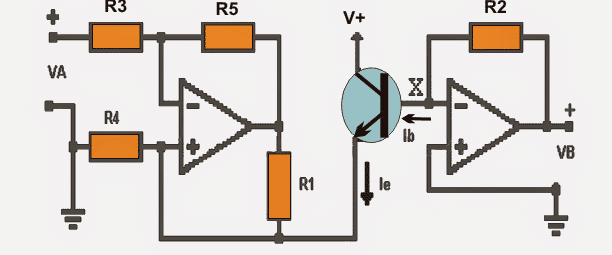In this post we'll study a simple opamp circuit design which can be applied for measuring the beta or the forward current gain of a particular BJT in question.
What is beta (β)
The beta (β) is the forward current gain that every BJT inherently possesses. It determines the efficiency of the particular device in terms of its ability to amplify current.
These values can be fundamentally found in the datasheets of the particular device through minimum or approximate of the actual (practical) values.
This implies that one may not know the real forward gain value of a BJT until its tested practically in a given circuit. This may be a tedious looking unless we are able to do it with a simple circuit as I have explained below:
Note that two transistors with the same name (eg BC547) may have different betas. The following circuit can obtain the value of a specific transistor beta.
Operational Details
Referring to the circuit diagram, we can see that it consists of a voltage to current converter on the left side of the transistor while a current to voltage converter on the right side. The voltage to current converter to the left becomes responsible of controlling the emitter current of the transistor just as a current to voltage converter may control the base current of a transistor (BJT).
The latter converter design is implemented easily by using an inverting opamp without including an input resistor.
It can be simulated that when powered the base current flows through the virtual ground (point X), the potential (voltage) is not affected by the current as long as the output VB is proportional to this current (Ib) input of the operational amplifier.
Now the circuitry that controls the emitter current is a current to voltage converter circuit that provides the current to the emitter of the transistor.
The base of transistor to held at zero (0) volts (when virtual ground feeds the inverting and non-inverting terminals of the operational amplifier) such that the voltage on the emitter is maintained at -Vbe.
This ensures that the emitter current is established with an input current to the voltage converter and the resulting base current is obtained by measuring the output voltage of the current-voltage converter.
That is,
= 1 + Ie / Ib. As Ie = VA / R1 and Ib = VBR2
= 1 + VA / R1 x R2 / VB = 1 + [VA x R2] / [VB x R1]
With R1 = R4 = 1k, R2 = R3 = R5 = 100K, = 1 + [VA x 100K] / [VB x 1K].
Substituting V+ = VA, beta (β) of the transistor is obtained from the formula:
β = 1 + 100 V+ / VB
Circuit Diagram


Need Help? Please Leave a Comment! We value your input—Kindly keep it relevant to the above topic!